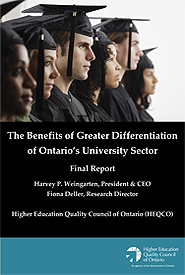
The report, 52 pages called The Benefits of Greater Differentiation of Ontario’s University Sector, supports a centralized planning approach & calls for a system of specialization to be imposed on the province’s universities.
The Higher Education Quality Council of Ontario (HEQCO) is calling for greater differentiation among Ontario’s universities to achieve higher global rankings and greater efficiencies in education delivery.
In a
policy paper released Oct. 26, the education council says a differentiated university sector, in which universities compete for limited public funding, would lead to positive improvements in quality of education and international recognition.
The HEQCO, an agency of the Ontario government, was asked to explore the benefits of greater differentiation, and relied on a small working group consisting of primarily university presidents to formulate its position.
The report recommends a multi-year accountability framework under which universities would develop mission statements around core priorities in negotiation with the province’s training, colleges and universities ministry. The province’s funding decisions would be based on how well the universities meet the stated goals.
University administrators typically finalize planning for future semesters and campus programs through consultation with their various stakeholders, including program heads, students, alumni, the community, the professoriate and the province. The proposed specialization model would see the ministry play a much more central role in planning, and “inevitably it will be called upon to say no to some elements forwarded by some institutions,” says the online report.
The report also predicts universities will agree to loss of autonomy in academic planning if it is tied directly to funding: “Put simply, universities will do what you fund them to do.”
The Council of Ontario Universities, which represents top administrators in the province’s publicly funded institutions, welcomed the report, saying the education council had initiated a platform for dialogue.
But implementing HEQCO’s model would be a mistake the Ontario chapter of the Canadian Federation of Students and the Ontario Confederation of University Faculty Associations said, because the proposed system of university funding would result in decreased access and compromise academic freedom and institutional autonomy.
Ontario is not the first jurisdiction looking to reorganize the post-secondary system using a policy of differentiation and increased government control as a strategy to meet increased student enrolment without increasing public investment.
In Nova Scotia, the O’Neill report, released in September, called for elements of the province’s universities to be merged and restructured, deregulation of tuition and specialization of programs. The report sparked heated criticism from the Association of Nova Scotia University Teachers that claimed O’Neill’s recommendations legitimized the continued underfunding of post-secondary education.
Across the Atlantic, a proposed 40 per cent cut to the UK’s higher education budget has universities scrambling to decide which programs will survive and which will disappear.